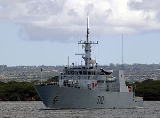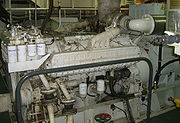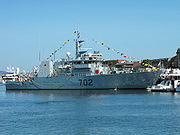
Kingston class patrol vessel
Encyclopedia
The Kingston-class consists of 12 coastal defence vessels
Patrol boat
A patrol boat is a relatively small naval vessel generally designed for coastal defense duties.There have been many designs for patrol boats. They may be operated by a nation's navy, coast guard, or police force, and may be intended for marine and/or estuarine or river environments...
operated by the Royal Canadian Navy
Royal Canadian Navy
The history of the Royal Canadian Navy goes back to 1910, when the naval force was created as the Naval Service of Canada and renamed a year later by King George V. The Royal Canadian Navy is one of the three environmental commands of the Canadian Forces...
.
The class is the name for the Maritime Coastal Defence Vessel Project
Maritime Coastal Defence Vessel Project
The Maritime Coastal Defence Vessel Project was a procurement project undertaken by the Department of National Defence beginning in the mid-1980s to find a replacement for the , and minesweepers....
(MCDV). These multi-role vessels were built and launched from the mid- to late-1990s and are crewed entirely by members of the Naval Reserve, with the exception of two regular-force technicians per crew.
Their main missions are coastal surveillance, sovereignty patrol, route survey, and training. They were designed with a minesweeping role in mind and are consequently classified as Mechanical Minesweepers (MM); however, this role has diminished as a result of the evolving nature of mine warfare
Naval mine
A naval mine is a self-contained explosive device placed in water to destroy surface ships or submarines. Unlike depth charges, mines are deposited and left to wait until they are triggered by the approach of, or contact with, an enemy vessel...
. The possibility of acquiring the gear necessary to undertake a more appropriate mine-hunting role continues to be examined.
Design
The Kingston-class patrol vessels have many admirable qualities, including crew comfort and ship manoeuvrability, but they represent some design compromises. The program was conceived to advance the use of commercial, off-the-shelf (COTS) equipment and construction techniques in a ship designed to military specifications.While the Z-drive
Z-drive
A Z-drive is a type of marine propulsion unit. Specifically, it is an azimuth thruster. The pod can rotate 360 degrees allowing for rapid changes in thrust direction and thus vessel direction...
thrusters make the Kingston-class vessels extremely manoeuvrable (able to turn within their own shiplength) and the engines are quite powerful and fuel-efficient, the hull shape, with a blunt stern and "hard" chine
Chine (boating)
A chine in boating refers to a sharp angle in the hull, as compared to the rounded bottoms of most traditional boat hulls. The term hard chine indicates an angle with little rounding, where a soft chine would be more rounded, but still involve the meeting of distinct planes. Chine log...
designed for minesweeping, prevents the ship from achieving a "sprint" speed and the patrol vessels of other nations are considerably faster. However, the Kingstons' top speed is faster than that of most mine warfare vessels and is comparable to most large non-naval sea-going vessels.
The hull is a longitudinally framed structure and has been designed to minimise steel weight. The construction involved initial production of partially outfitted steel modules which were made into sub-assemblies and then integrated into the ship. The decks were assembled upside down with pre-outfitting of the underside of the deck prior to installation on the ship. In contrast to many modern mine warfare vessels, which often have hulls made of non-magnetic glass-reinforced plastic
Glass-reinforced plastic
Fiberglass , is a fiber reinforced polymer made of a plastic matrix reinforced by fine fibers of glass. It is also known as GFK ....
or similar material, the Kingston class have conventional steel hulls. The vessels are, however, equipped with a magnetic degaussing
Degaussing
Degaussing is the process of decreasing or eliminating an unwanted magnetic field. It is named after Carl Friedrich Gauss, an early researcher in the field of magnetism...
system that allows the ship's magnetic signature to be manipulated in three dimensions to minimize vulnerability to magnetic mines.
Modular payload
Kingston class vessels are designed to carry up to three 20 feet (6.1 m) ISO containersIntermodal container
An intermodal container is a standardized reusable steel box used for the safe, efficient and secure storage and movement of materials and products within a global containerized intermodal freight transport system...
with power hookups on the open deck aft in order to embark mission-specific payloads. As of 2009, the available modules included:
- 2 x Indal Technologies AN/SLQ 38 deep mechanical minesweeping systems
- 4 x MDA Ltd. AN/SQS 511 heavy-weight high-definition route survey systems
- 1 x ISE Ltd. Trailblazer 25 bottom object inspection vehicle
- 1 x ISE Ltd. HYSUB 50 deep seabed intervention system
- 2 x Fullerton and Sherwood Ltd. 6-man, 2-compartment containerised diving systems
- 6 x naval engineered 6-person accommodation modules
- 1 x MDA Ltd. Interim Remote Minehunting and Disposal System
Weapons
The ships are equipped with a Bofors 40 mmBofors 40 mm gun
The Bofors 40 mm gun is an anti-aircraft autocannon designed by the Swedish defence firm of Bofors Defence...
Model 60 Mk 5C rapid fire gun, and two 12.7 mm (50 cal) machine guns. The Bofors gun is mounted on the forecastle deck and the arc of fire extends forwards by +/- 120°. The machine guns are mounted on either side at the front of the bridge deck. In a depressed position each machine gun fires in an 118° arc.

World War II
World War II, or the Second World War , was a global conflict lasting from 1939 to 1945, involving most of the world's nations—including all of the great powers—eventually forming two opposing military alliances: the Allies and the Axis...
Bofors design that is manually loaded and lacks modern targeting capability.
In October 2006, Maritime Command experimented with mounting a remote controlled heavy machine gun station, the OTO Melara 12.7 mm RCHMG, in place of the 40 mm Bofors cannon aboard HMCS Summerside.
Sensors
The navigation equipment includes a Sperry Marine Bridge Master E I-band navigation radar and a Global Positioning SystemGlobal Positioning System
The Global Positioning System is a space-based global navigation satellite system that provides location and time information in all weather, anywhere on or near the Earth, where there is an unobstructed line of sight to four or more GPS satellites...
. The surface search radar is the E to F-band Sperry Marine Bridge Master E. A towed high-frequency sidescan sonar can be fitted for bottom mapping and route surveys.
Propulsion

Deployment and operations
The ships are evenly distributed between the east and west coasts.One vessel on each coast is maintained for rapid deployment: this responsibility is rotated amongst the ships.
Future of the class
The Royal Canadian Navy is discarding a $100M mid-life refit plan for the twelve vessels in this class. Instead, MCDVs will be replaced by new vessels to enter service in 2020. It had been intended to retain the ‘mid-lifed’ vessels through 2045–2055; however, the RCN has concluded that the money would be better spent in acquiring a new platform. The RCN review listed low speed and small size as reasons for the MCDV being inadequate for patrol duties (both are factors of the original specification). Notwithstanding the success of the ships in their deployment, critics suggest that patrol and training were tacked onto the mine-countermeasures role and that the platform lacks serious armament for a sovereignty enforcement role.On May 13, 2010 it was announced that six of the twelve MCDVs would be placed in extended readiness due to lack of funds and the inability of the naval reserve to provide sufficient personnel to man the ships. On May 14 however that order was rescinded.
- Builders:
 Halifax Shipyards Ltd., Halifax
Halifax Shipyards Ltd., Halifax - Laid down: 12 December 1994
- Launched: 12 August 1995
- Operator: Royal Canadian Navy
- Commissioned: 21 September 1996
- Status: In active service
- Modifications:
- Operations:
- Builders:
 Halifax Shipyards Ltd., Halifax
Halifax Shipyards Ltd., Halifax - Laid down: 28 April 1995
- Launched: 22 January 1996
- Operator: Royal Canadian Navy
- Commissioned: 26 October 1996
- Status: In active service
- Modifications:Oto Melara 12.7mm RWS
- Operations:

- Builders:
 Halifax Shipyards Ltd., Halifax
Halifax Shipyards Ltd., Halifax - Laid down: 11 August 1995
- Launched: 17 May 1996
- Operator: Royal Canadian Navy
- Commissioned: 10 May 1997
- Status: In active service
- Modifications:
- Operations:

- Builders:
 Halifax Shipyards Ltd., Halifax
Halifax Shipyards Ltd., Halifax - Laid down: 8 December 1995
- Launched: 31 October 1996
- Operator: Royal Canadian Navy
- Commissioned: 21 June 1997
- Status: In active service
- Modifications:
- Operations:
- Builders:
 Halifax Shipyards Ltd., Halifax
Halifax Shipyards Ltd., Halifax - Laid down: 26 April 1996
- Launched: 15 November 1996
- Operator: Royal Canadian Navy
- Commissioned: 14 June 1997
- Status: In active service
- Modifications:
- Operations:
- Builders:
 Halifax Shipyards Ltd., Halifax
Halifax Shipyards Ltd., Halifax - Laid down: 26 July 1996
- Launched: 24 February 1997
- Operator: Royal Canadian Navy
- Commissioned: 17 April 1998
- Status: In active service
- Modifications:
- Operations:

- Builders:
 Halifax Shipyards Ltd., Halifax
Halifax Shipyards Ltd., Halifax - Laid down: 7 November 1996
- Launched: 5 June 1997
- Operator: Royal Canadian Navy
- Commissioned: 18 April 1998
- Status: In active service
- Modifications:
- Operations:
- Builders:
 Halifax Shipyards Ltd., Halifax
Halifax Shipyards Ltd., Halifax - Laid down: 22 February 1997
- Launched: 4 September 1997
- Operator: Royal Canadian Navy
- Commissioned: 26 July 1998
- Status: In active service
- Modifications:
- Operations:
- Builders:
 Halifax Shipyards Ltd., Halifax
Halifax Shipyards Ltd., Halifax - Laid down: 31 May 1997
- Launched: 5 December 1997
- Operator: Royal Canadian Navy
- Commissioned: 12 July 1998
- Status: In active service
- Modifications:
- Operations:
- Builders:
 Halifax Shipyards Ltd., Halifax
Halifax Shipyards Ltd., Halifax - Laid down: 5 September 1997
- Launched: 30 March 1998
- Operator: Royal Canadian Navy
- Commissioned: 5 December 1998
- Status: In active service
- Modifications:
- Operations:

- Builders:
 Halifax Shipyards Ltd., Halifax
Halifax Shipyards Ltd., Halifax - Laid down:
- Launched:
- Operator: Royal Canadian Navy
- Commissioned: 5 June 1999
- Status: In active service
- Modifications:
- Operations:

- Builders:
 Halifax Shipyards Ltd., Halifax
Halifax Shipyards Ltd., Halifax - Laid down:
- Launched:
- Operator: Royal Canadian Navy
- Commissioned: 18 July 1999
- Status: In active service
- Modifications:
- Operations:
See also
Other similar class coastal defence vessels:Other Canadian Forces Naval Vessels:
- Halifax class frigateHalifax class frigateThe Halifax-class frigate is a class of multi-role patrol frigates that have served the Royal Canadian Navy since 1992...
(hull designation FFH)

